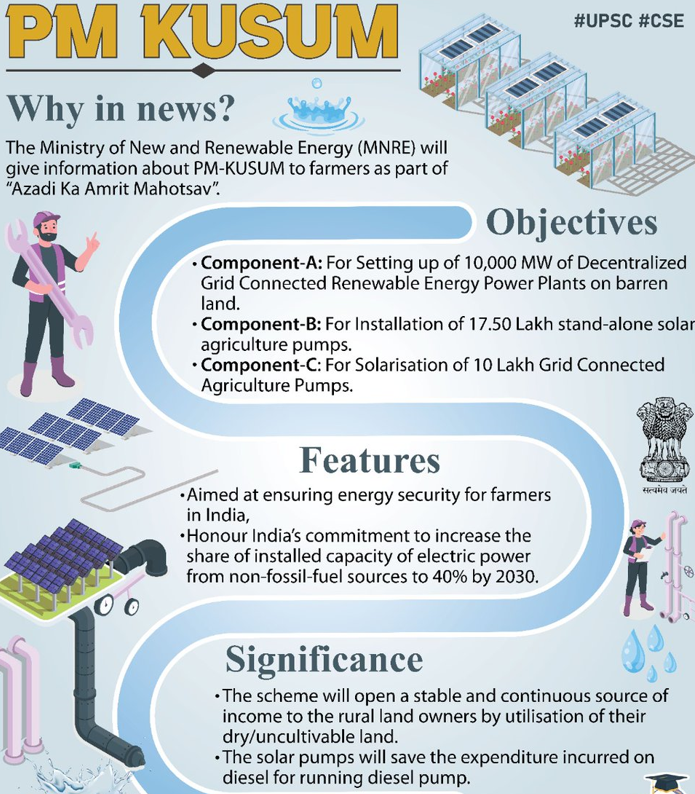[ad_1]
Context:
The Union Minister of Power, New and Renewable Energy recently reviewed the progress of the PM-KUSUM scheme and reaffirmed the government’s commitment to accelerating solar pump adoption.
Launched in 2019, PM-KUSUM aims to help farmers access reliable day-time solar power for irrigation, reduce power subsidies, and decarbonise agriculture. But pandemic-induced disruptions, limited buy-in from States, and implementation challenges have all affected the scheme’s roll-out.
In a year when patchy and delayed monsoons have hit kharif crops in most of the country, PM-KUSUM assumes increased significance.
Background: Kisan Urja Suraksha evam Utthaan Mahabhiyan (KUSUM) Scheme:
The Government of India is formulating a Scheme ‘Kisan Urja Suraksha evam Utthaan Mahabhiyan (KUSUM)’ which aims to promote use of solar energy among the farmers.
The PM-KUSUM scheme was launched by the Ministry of New and Renewable Energy (MNRE) to support installation of off-grid solar pumps in rural areas and reduce dependence on grid, in grid-connected areas.
The proposed scheme provides for:
- Setting up of grid-connected renewable power plants each of 500 KW to 2 MW in the rural area,
- Installation of standalone off-grid solar water pumps to fulfil irrigation needs of farmers not connected to grid, and
- Solarization of existing grid-connected agriculture pumps to make farmers independent of grid supply and also sell surplus solar power generated to DISCOM and get extra income.
- The farmers will have to tolerate only 10% of the total expenditure to acquire an install a solar pump. The Central Govt. will provide 60% cost while the remaining 30% will be taken care of by bank as credit.
Barriers to uptake:
- PM-KUSUM provides farmers with incentives to install solar power pumps and plants in their fields.
- They can use one of three deployment models: off-grid solar pumps, solarised agricultural feeders, or grid-connected pumps.
- Off-grid pumps have been the most popular, but the nearly 2,80,000 systems deployed fall far short of the scheme’s target of two million by 2022.
- Barriers to adoption include limited awareness about solar pumps and farmers’ inability to pay their upfront contribution.
- Progress on the other two models has been rather poor due to regulatory, financial, operational and technical challenges.
- Only a handful of States have initiated tenders or commissioned projects for solar feeders or grid-connected pumps.
- Yet, both models are worth scaling up for they allow farmers to earn additional income by selling solar power to DISCOMS, and DISCOMS to procure cheap power close to centres of consumption.
How can we unlock the various opportunities of KUSUM promises?
Experts proposed five steps for tackling the myriad challenges linked to PM-KUSUM’s implementation.
- First, extend the scheme’s timelines. Most Indian DISCOMS have a surplus of contracted generation capacity and are wary of procuring more power in the short term.
- Extending PM-KUSUM’s timelines beyond 2022 would allow DISCOMS to align the scheme with their power purchase planning.
- Second, create a level playing field for distributed solar plants. Selling surplus power to DISCOMS is one of the main attractions of grid-connected models.
- Yet, DISCOMS often find utility-scale solar cheaper than distributed solar (under the scheme) due to the latter’s higher costs and the loss of locational advantage due to waived inter-State transmission system (ISTS) charges.
- To tackle the bias against distributed solar, we need to address counter-party risks and grid-unavailability risks at distribution substations, standardise tariff determination to reflect the higher costs of distributed power plants, and do away with the waiver of ISTS charges for solar plants.
- Third, streamline land regulations through inter-departmental coordination.
- Doing so will help reduce delays in leasing or converting agricultural lands for non-agricultural purposes such as solar power generation.
- States should constitute steering committees comprising members from all relevant departments for this purpose.
- Fourth, support innovative solutions for financing farmers’ contributions. Many farmers struggle to pay 30-40% of upfront costs in compliance with scheme requirements.
- Further, they cannot access bank loans without collateral. While some States have increased subsidy support, this solution is not scalable.
- To ease the financial burden on farmers, we need out-of-the-box solutions.
- Consider Karnataka’s pilot of a farmer-developer special-purpose vehicle to help farmers install solar power plants on their farms.
- Another promising example is a community-owned model piloted in Chhattisgarh and Jharkhand, which could help marginalised farmers own and access off-grid pumps with limited upfront contributions.
- Fifth, extensively pilot grid-connected solar pumps. Current obstacles to their adoption include concerns about their economic viability in the presence of high farm subsidies and farmers’ potential unwillingness to feed in surplus power when selling water or irrigating extra land are more attractive prospects.
- Further, the grid-connected model requires pumps to be metered and billed for accounting purposes but suffers from a lack of trust between farmers and DISCOMS.
- Adopting solutions like smart meters and smart transformers and engaging with farmers can build trust and address some operational challenges.
- But piloting the model under different agro-economic contexts will be critical to developing a strategy to scale it up in an economically and operationally sustainable manner.
Conclusion:
The above-mentioned measures, combined with other agriculture schemes and complemented by intensive awareness campaigns, could give a much-needed boost to PM-KUSUM.
Consensus between the Centre and States is the key to the success of this decentralised solar power scheme.
Any reform in India’s power space cannot take place unless there is consensus between the Centre, States and stakeholders.
Apart from switching to solar power, farmers should also switch over to drip irrigation mode which saves water and power with increased crop output.
If successful, the KUSUM scheme can generate hundreds of thousands of jobs, vastly reduce the carbon footprint of Indian agriculture, and result in oil import savings.
[ad_2]


